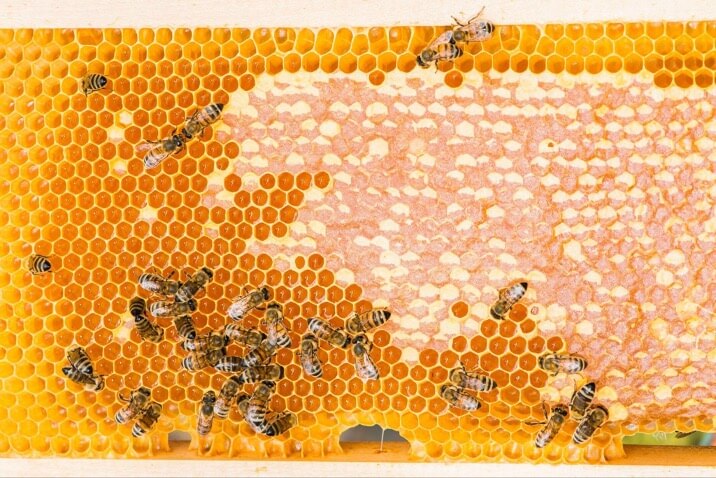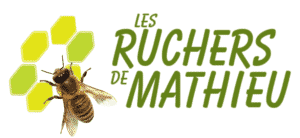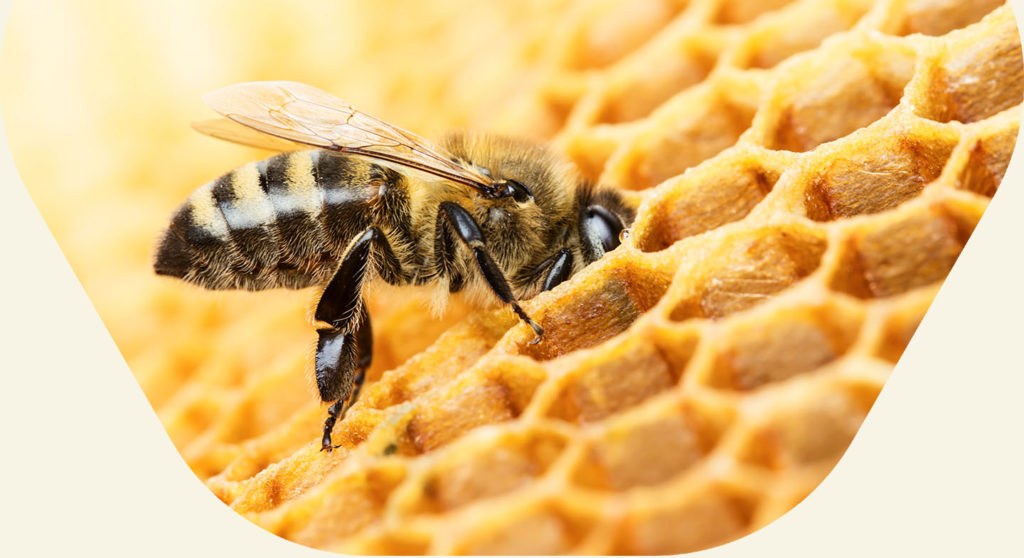How do bees keep warm in winter?
In winter, many insects protect themselves from the cold and bad weather before spring arrives. Honey bees are among them. They need to keep the heat they generate inside the hive. The survival of the colony depends on it!
Because of the cold, the bees don’t go outside and stay grouped together in the centre of the hive to form what is known as a cluster. This means they don’t move around much, especially when it comes to feeding, which is why a bee fondant like Apifonda is placed just above their heads to encourage them to take it. Thanks to this energy supply, they regularly contract their thoracic muscles to produce heat. In this way, they are able to maintain a group temperature of over 10°C, ensuring their survival whatever the outside temperature. As soon as the fine weather returns, the temperature in the hive will gradually rise to around 35°C: the optimum temperature for the development of the eggs and larvae that will replace the adult workers who have spent the whole winter.
Research has shown the bees’ ability to warm up the hive using thermal cameras. Even if beginner beekeepers often want to open their hives to check whether their bees have died, they should refrain from doing so because of the season. Opening the hive in winter can quickly drop the temperature below 10°C, and the colony could die. So how do you know if the bees are doing well?
At best, some beekeepers use a so-called thermal camera, an infrared camera that allows them to see from the outside what’s going on inside without touching the bees. A blue-violet colour indicates that there is no heat, whereas a yellow and white dot indicates the exact position of the cluster of bees emitting heat. However, even if this device is excellent for monitoring life in beehives, we are not necessarily going to invest in this type of device to observe our bees.
The best thing to do is to be patient, having put in place all the necessary means for a good wintering period since last autumn: insulation from above, laying bee fondant, reducing the size of the entrance door and, more recently, insulation around the flight board, what beehive manufacturers call the ‘sock’ of the hive.
The beekeeping year for beginners?
Here’s a beekeeping calendar for those who are just starting out in beekeeping as an amateur. Of course, the tasks to be carried out each month are highly dependent on the region, altitude, type of hive, type of bee and many other factors.
In February, the bees are still clustered together to preserve the temperature of the hive, as we saw earlier. The first foragers make their clean-up flights to clear away wax debris and dead insects in the hive. The queen begins to lay eggs again with the first fine days, which will slowly reactivate the dynamics of the colony. This is the time for beginners to prepare their equipment, paint their hive and, above all, reserve a swarm for the spring.
March arrives, and in the south, the colonies are back in full swing. For their first season, beginner beekeepers will be able to read up on future practices. Experienced beekeepers will be making the traditional spring visit to take stock of the situation and check the bee population and food reserves in each hive.
April will already be better for our hobby beekeeping. Let’s get down to business! This is when our swarm should be ready for the breeder. It can then be installed in his garden. Then the hard work of observation begins, as week after week you have to increase the living space of your colony while stimulating the queen’s egg-laying with syrup. Once the hive body is full, it’s time to fit the top board.

In May, the main thing to watch out for is ‘swarm fever’, which could affect the largest colonies. Swarming fever occurs when a very large population of bees runs out of space in the hive. The queen and half her bees fly off to find refuge elsewhere. On your first test of the year, you should not observe this phenomenon. If the brood chamber starts to fill up well, you should keep a close eye on the available space during June and add a supper if necessary.
July-August is harvest time for beekeepers, depending on the region. At last you can get the precious honey out of your bees! But you’ll also need to think about treating your bees for Varroa mites, in which case you run the risk of losing your colonies early in the autumn. Summer is also the dreaded Asian hornet season! Trapping is the best way to avoid major attacks.
In September and October, the beekeeper will need to be vigilant about food intake. The colony should have enough frames of honey, pollen and attractive brood. You can intervene by re-feeding the swarm with syrup as long as it’s not too cold, and to build up the stock, and by candying (more often in winter) when they can no longer absorb the syrup. The entrances will have to be narrowed and the hive insulated. The colony’s winter cycle will begin in late autumn…
As usual, share your photos with us: we’ll post them on our website from the social networks with the hashtag: #apifonda #apiinvert!
See you next month on your API blog with your faithful partner, Les Ruchers De Mathieu!

LES RUCHERS DE MATHIEU Miellerie & Magasin d’Apiculture
Photos ©lesruchersdemathieu


